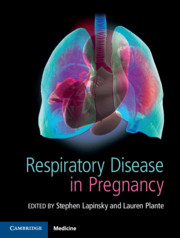Book contents
- Respiratory Disease in Pregnancy
- Respiratory Disease in Pregnancy
- Copyright page
- Contents
- Contributors
- Section 1 The Basics: for the Obstetrician
- Section 2 The Basics: for the Non-Obstetrician
- Section 3 Pulmonary Conditions Not Specific to Pregnancy
- Section 4 Pulmonary Conditions Related to Pregnancy
- Section 5 Other Pulmonary Issues in Pregnancy
- Index
- References
Section 4 - Pulmonary Conditions Related to Pregnancy
Published online by Cambridge University Press: 14 April 2020
- Respiratory Disease in Pregnancy
- Respiratory Disease in Pregnancy
- Copyright page
- Contents
- Contributors
- Section 1 The Basics: for the Obstetrician
- Section 2 The Basics: for the Non-Obstetrician
- Section 3 Pulmonary Conditions Not Specific to Pregnancy
- Section 4 Pulmonary Conditions Related to Pregnancy
- Section 5 Other Pulmonary Issues in Pregnancy
- Index
- References
- Type
- Chapter
- Information
- Respiratory Disease in Pregnancy , pp. 159 - 176Publisher: Cambridge University PressPrint publication year: 2020



